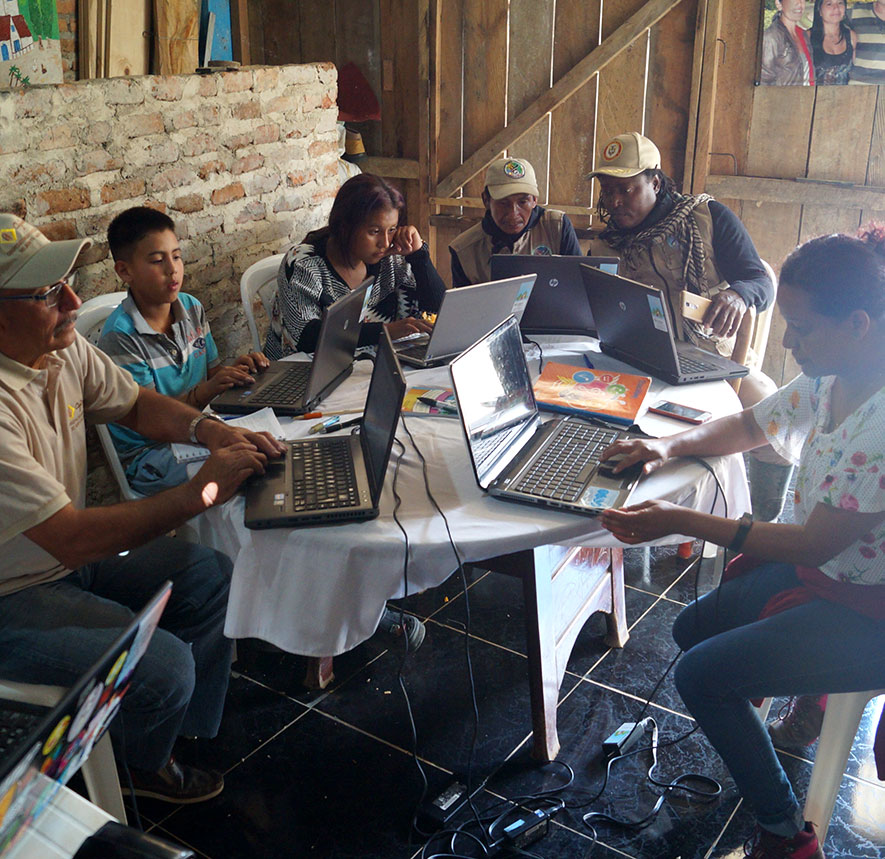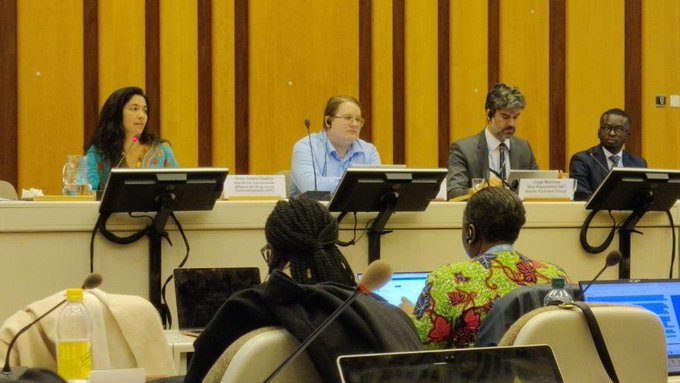
In its input to the UN’s Global Digital Compact (GDC) earlier this year, APC pointed out that "without consideration of the local realities and needs, simply ‘connecting everyone’ may have adverse effects rather than positive ones oriented to ensure social, environmental and gender justice, as well as an open, free and secure digital future." So how can governments, international organisations, private companies and civil society work together to close the digital divide while improving access skills and meaningful connectivity, leaving no one behind?
This vital question was also posed to diverse state officials and other stakeholders during the GDC deep-dive session on digital inclusion and connectivity in April. The GDC is a framework of principles proposed by UN Secretary-General António Guterres, to be agreed upon during the UN’s Summit of the Future in 2024. At the deep-dive session, many country representatives expressed concerns about problems related to getting the whole world connected, such as protection of privacy, attacks on democracies and gender imbalances. The social and environmental impact of extractivism could be added to the list. At the same time, the GDC dialogue also brought recognition that the internet is an enabler of human rights, development and social, gender and environmental justice.
An example from Brazil shared in a country report by the civil society organisation Intervozes and the Centre for Communication, Democracy and Citizenship at the Federal University of Bahia, serves as a concrete demonstration of this point in the latest edition of APC’s flagship publication Global Information Society Watch (GISWatch). We learn from Ednalva Rita, the president of a community association called Caiana dos Crioulos, who shared the educational reality faced by people in rural communities in Brazil during the COVID-19 pandemic: “It was difficult for the remote classes to happen here in the community, because only 5% of the community has internet – we are 130 families here. There are 187 students in the elementary school. Imagine this number of students without internet connections to carry out online activities.”
Another voice from the local communities points to the complexity of a reality made up by many layers of imbalance when it comes to internet connectivity: “I have neither good nor bad internet, and even if I did, I wouldn't know how to participate in online meetings,” said Maria de Fátima, a shellfish gatherer and fisherwoman from the quilombola community [1] of Tororó in Bahia. “When it comes to these electronic things, these advanced machines, my child, I don't know anything: where it goes, where it comes from. I am sorry."
According to the authors, "her vent demonstrates the culpability of technopolitics in unequal environments", which “subjects digitally excluded people to the construction of digital architectures which are incomprehensible to the diversity of ways of life.”
This report from Brazil is one of a total of 15 regional and country reports that specifically raised internet access as a key issue that impacted on the realities being portrayed – almost half of the 36 reports featured in this GISWatch edition, which focus on “Digital futures for a post-pandemic world".
Starting from such a complex scenario, how is it possible to equalise this situation and promote connectivity to co-create a free, safe and worthwhile digital future?
Bottom-up and multistakeholder decision-making processes
When sharing APC’s learnings from community-led initiatives through the years, three pillars were highlighted by APC representative Valeria Betancourt as important guidelines moving forward at the GDC processes: 1) building inclusive participation of communities in policy making concerning access and digital inclusion; 2) providing space and means for alternative solutions to connectivity that prioritise local and community-led responses; and 3) fostering a multistakeholder approach with differentiated roles and responsibilities.
“Bottom-up participation and multistakeholder decision-making processes are crucial for a free and open internet that allows people to exercise individual and collective agency, transform power relations and make access meaningful. People give meaning to connectivity, not a single definition of what meaningful means,” said Betancourt.
In a similar vein, Julian Casasbuenas, from Colombian APC member organisation Colnodo, called for the recognition of community-led initiatives by governments and the private sector. “We believe that community networks can make a contribution to the purpose of connecting all people to the internet,” said Casasbuenas, explaining that the term “community network” refers to telecommunications infrastructure implemented and operated by a local group to meet their own communication needs.
Such recognition is still slight, but is evolving. During the GDC deep-dive session, government representatives from Mexico and the United Kingdom pointed out the important achievements of community networks in remote areas and reinforced the need for complementary connectivity approaches.
While these recognitions are vital, the next steps require translating them into tangible and practical enablers for the communities making change happen.

Photo shared by Colnodo for this interview with Julián Casasbuenas
Learning from communities
While seeing how the internet can bring both negative and positive impacts in the world shows that there is no magical solution, there is a promising entry point happening within the community networks movement: the combination of complementary connectivity alternatives with processes to strengthen the social appropriation of information and communications technologies (ICTs) by communities around the world.
One concrete example of this combination was described by María Florencia Roveri from APC member Nodo TAU in a country report about Argentina in the latest edition of GISWatch. The strong participation of civil society promoting internet access centred on the communities in the country fostered groundbreaking policies and many achievements in terms of free technologies and digital skills building.
“The community networks movement in Argentina has developed tools and methodologies for expanding community networks, such as the production of the LibreRouter and the development of community training methodologies – efforts that have made some community networks in the country worldwide pioneers,” Roveri explained. “The organisation AlterMundi is a good example. It promoted the Roberto Arias Programme, supporting organisations and sharing community network experiences during the pandemic.”
The Roberto Arias Programme was launched in June 2021 by the telecoms regulator, ENACOM, aiming to respond to the connectivity needs of rural and Indigenous communities, while promoting self-management through community networks. The programme represents a recognition of the need for specific public policies for these areas and the importance of alternatives that start in the community. It was seeded in participatory processes and incorporated community networks as beneficiaries of Argentina’s Universal Service Fund (USF).
The importance of community-led approaches has also been reinforced in the new Routing for Communities podcast. Natalia Vinelli, the deputy director of Special Projects at ENACOM, said in episode 5 about the state programmes centred on community-led alternatives for connectivity: “None of this would have been possible if there had not been a social movement, which set an agenda, and which also defined that their peers from the social movement occupy spaces in the state, to push that agenda towards reality.”

Jessica Giudice, from AlterMundi, shares learnings from community network experiences during the ITU-Development deep dive into an enabling environment for meaningful connectivity (May 2023). Photo: Mike Jensen.
Collaborative processes
Argentina is part of a community networks movement flourishing in different parts of the world. Their multiple experiences have been showing that it is possible to build collaborative processes to deal with complex contradictions collectively and grounded in lived realities.
Their achievements and challenges offer a learning opportunity for a very emerging issue: the “accelerated transition” to digitalisation and increased need for connectivity spurred by the COVID-19 pandemic, as shown by multiple GISWatch reports. The report from Brazil, which featured the testimonials from people like Ednalva and Maria de Fátima presented above, concludes: “In this scenario, we cannot consider the denial of access to the internet and ICTs as if it is detached from the historical violations performed by the Brazilian state against the most vulnerable groups. In the same way, it is necessary to consider the demand for digital rights as part of the demand for the ‘right to exist’.”
The action steps recommended to deal with these imbalances include the need to strengthen the capacities of Black women, traditional peoples and communities, and people with disabilities in order to help them develop digital rights initiatives and foster community-driven uses of technology, ensuring the autonomy of these groups. Another is the guarantee of prior and informed consent through consultation with traditional peoples and communities on public policies in different areas.
The Brazil report shows that placing the knowledge from marginalised communities – who have been defending their rights, lands and well-being for many years – at the centre of multistakeholder collaboration can emerge as a milestone of hope when navigating such challenging times. And that is precisely what Argentina is trying to do at this moment. These experiences are showing that there is no single solution for the digital divide. The solutions must be as many as necessary to guarantee the self-determination of communities that cultivate different ways of living. And the processes where decisions are made and policies are designed need to take this into account.
Suggested materials to find out more:
- Global Information Society Watch (GISWatch): Digital futures for a post-pandemic world
- The reports from Brazil and Argentina for the latest GISWatch editon
- The APC network intervenes at the Global Digital Compact's deep dive session on digital inclusion and connectivity
- Routing for Communities podcast: An audio journey tracing community connectivity around the world
[1] Quilombos are settlements formed by Black people who escaped repression during the period of slavery in Brazil. The current inhabitants of these communities, descendants of their founders, are called quilombolas.
Featured image: Collective drawing about dreams for the future co-created by participants from Latin America and the Caribbean during the LocNet Regional Meeting. Photo: Dario Celestino.